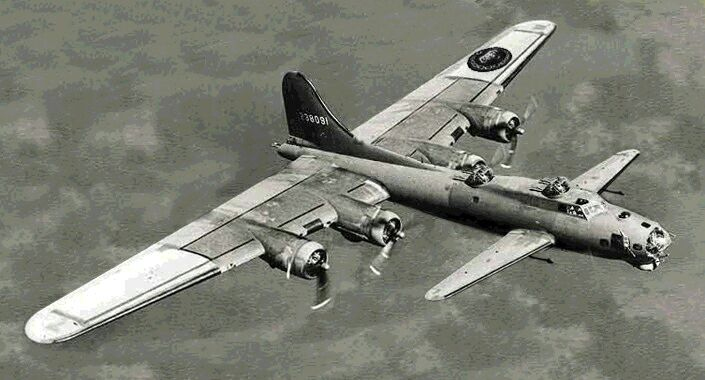If Burt Rutan had designed the B-17
Sat Oct 03, 2009 12:02 pm
I just came across this and just had to share it:
If Burt Rutan had designed the Boeing B-17, it would have looked like this:

How cool is that?
If Burt Rutan had designed the Boeing B-17, it would have looked like this:

How cool is that?
burts b17
Sat Oct 03, 2009 12:56 pm
if burt had anything to do with it, it would have worked and it even looks like it have worked
Sat Oct 03, 2009 12:59 pm
Gotta love the CG on that design. With the bomb bay and wing positions and all lol.
Sat Oct 03, 2009 1:16 pm
YB-40-RU 
Sat Oct 03, 2009 1:26 pm
Edward Sheetmetalhands wrote:YB-40-RU
Yeah, I noticed the extra dorsal turret, too. I was waiting for someone else to comment....
On the other hand:
BHawthorne wrote:Gotta love the CG on that design. With the bomb bay and wing positions and all lol.
What about the landing gear configuration? The mains are still visible under the inboard nacelles. It's gotta need a nose wheel!
Sat Oct 03, 2009 1:35 pm
Yup, it would have to have a MASSIVE nose gear....but where? Take from Bomb bay? Bombardier/Nave Compartment? This one has been floating on the web for quite some time.
Sat Oct 03, 2009 2:50 pm
Rajay wrote:
Yeah, I noticed the extra dorsal turret, too. I was waiting for someone else to comment....
What's the problem...ya' can't have too many guns.
Mudge the armed
Sat Oct 03, 2009 3:23 pm
Mudge wrote:Rajay wrote:
Yeah, I noticed the extra dorsal turret, too. I was waiting for someone else to comment....
What's the problem...ya' can't have too many guns.
Mudge the armed
Apparently you can have too many guns. The problem is the weight of the guns and the amount of ammunition (and its weight) that you have to carry:
Excerpts from pp 46 – 50 of Roger A. Freeman’s
The Mighty Eighth: A History of the U. S. 8th Army Air Force
“The third squadron (of the 92nd BG) at Alconbury, the 327th, was equipped with twelve YB-40s, a secret, experimental version of the Fortress, intended for a formation defense role.
Vega Aircraft Corporation did the initial work and in August 1942 converted a B-17F into the XB-40. After satisfactory preliminary tests, thirteen experimental models were ordered between November (1942) and March (1943). These Vega-built B-17Fs were turned into YB-40s at the Douglas modification center at Tulsa, by installing power turrets, one amidships over the radio room and the other, a neat, remotely controlled installation, under the nose, and (double) gun positions in waist windows. These gave the aircraft a total of fourteen .50 machine guns against the nine for the standard B-17F.
On the YB-40, a prodigious amount of ammunition (some 12,400 rounds) was allowed for and much armor plate added at crew stations.
May 29th (1943) was also the occasion of the YB-40s debut when seven were sent out with leading elements of the St. Nazaire force. Their performance was not a success. Shortcomings had been evident soon after their arrival at Alconbury; before they could be flown in combat it was necessary to install ammunition feed chutes to eliminate the manhandling of ammunition to some positions. But the most troublesome aspect of the YB-40 was its flying characteristics, particularly its tendency to fly tail heavy due to the added weight in the rear section. On this first mission, they flew in leading positions, but after the B-17s had bombed, the YB-40s, still laden with ammunition, could not keep pace, thereby forcing the whole formation to reduce speed.”
Sat Oct 03, 2009 5:42 pm
amasing! 
Sat Oct 03, 2009 11:50 pm
Think I know what I'm going to do with the B-17 kit that is in my closet!
Sun Oct 04, 2009 1:58 am
Is that the next variant of the Stratolina? 
Sun Oct 04, 2009 2:06 am
Cute, but with no waist guns, a poorly defended goose... May have turrets, but you need those waist gunners. If it had them, they'd shoot out the props!
Robbie
Robbie
Sun Oct 04, 2009 6:36 am
it has old mutton chops rutan's sideburns written all over it. it actually looks pretty cool to me!! somebody knows how to majorally photoshop!! great work!!
Sun Oct 04, 2009 9:35 am
PbyCat-Guy wrote:Think I know what I'm going to do with the B-17 kit that is in my closet!
I don't have a spare model kit in the closet, but I had the same thought.
Unless there is a kit of the YB-40 available, it might take two B-17 kits to produce the Rutan canard version shown above. Gotta get the second dorsal turret from somewhere.
This also reminds me of a time back in high school, right after Star Wars came out (1977-1978 or so). My best friend and I were doing something similar with old model kits and I topped his efforts by coming up with my own Star Wars type "Tie-fighter" (X-wing, whatever) by grafting the forward fuselage of a 1/48 scale F-16 to the engine pods of a 1/72 A-10 Warthog and adding some airfoils made from the horizontal stabs of the F-16. It was pretty cool how the forebody strakes of the F-16 blended right into the natural curve of the A-10 engine pods.
He also gave me points for painting it black. Star Trek always got it wrong! In space, why in the heck would you paint a warship WHITE?
Sorry for the detour....
Sun Oct 04, 2009 9:46 am
Rajay wrote: Star Trek always got it wrong! In space, why in the heck would you paint a warship WHITE?
That's a trick question, right?
